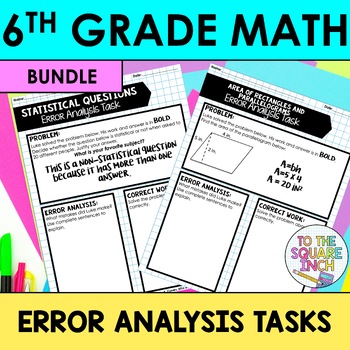6th Grade Math Error Analysis
- Zip
What educators are saying
Products in this Bundle (6)
showing 1-5 of 6 products
Also included in
- Middle School Math Error Analysis Tasks Bundle - One task for each Common Core StandardThere is one task per page that includes a problem with incorrect work, space for students to explain in words why the work is incorrect, and space to solve the problem correctly.*Worked out answer key with correcPrice $50.00Original Price $69.25Save $19.25
- 6th Grade Math Ultimate Bundle Unlock a world of math excellence with this comprehensive 6th Grade Math Ultimate Curriculum Bundle. This all-in-one resource is the key to ensuring your students not only grasp mathematical concepts but thrive in their 6th-grade math journey.Unbelievable Savings: ThisPrice $600.00Original Price $1333.00Save $733.00
Description
6th Grade Math Error Analysis Tasks - One task for each Common Core Standard
70 different error analysis tasks for each 6th Grade Common Core Standard. This is a bundle of 5 different products at over a 20% discount. Please click on each link to see individual product descriptions.
Topics include:
Multiplying Fractions
Dividing Fractions
Dividing Mixed Numbers
Adding and Subtracting Decimals
Multiplying Decimals
Dividing Decimals by Whole Numbers
Dividing Decimals by Decimals
Greatest Common Factor
Least Common Multiple
Introduction to Integers
Negative Fractions and Decimals
Opposite Values
Reflecting Coordinates
Absolute Value
Comparing and Ordering Integers
Topics include:
Order of Operations
Algebraic Expressions Vocabulary
Writing Algebraic Expressions
Reading Algebraic Expressions
Evaluating Algebraic Expressions
Equivalent Expressions
Combining Like Terms
The Distributive Property
Writing Equations
Checking Solutions
Solving Equations with Addition and Subtraction
Solving Equations with Multiplication and Division
Writing Inequalities
Graphing Inequalities
Solving Inequalities with Addition and Subtraction
Solving Inequalities with Multiplication and Division
Equations in 2 Variables
Topics include:
Introduction to Ratios
Unit Rate
Equivalent Ratios
Ratio Tables
Ratios with Tape Diagrams
Comparing Unit Rates
Introduction to Percents
Percents and Fractions
Percents and Decimals
Percent of a Number
Finding the Whole
Converting Measurements
Topics include:
Area of Rectangles and Parallelograms
Area of Triangles
Area of Trapezoids
Area of Composite Figures
Volume of Rectangular Prisms
Volume of Rectangular Prisms with Fractional Edges
Distance in the Coordinate Plane
Polygons in the Coordinate Plane
Nets of 3-D Figures
Surface Area of Rectangular Prisms
Surface Area of Triangular Prisms
Surface Area of Pyramids
Topics include:
Shapes of Distributions
Finding Mean
Finding Mode
Finding Median
Finding Range
Quartiles
Interquartile Range (IQR)
Mean Absolute Deviation (MAD)
Line Plots
Histograms
Box and Whisker Plots
Stem and Leaf Plots
There is one task per page that includes a problem with incorrect work, space for students to explain in words why the work is incorrect, and space to solve the problem correctly.
*Worked out answer key with correct answers as well as correct sample responses
*Error Analysis cover (just incase you want to print a packet or a mini book)
Please note: These pages can easily be printed 2 per page or in a mini book to fit in an interactive notebook. If you are not sure how to do this, Google it! There are different ways depending on what PDF program and printer you have.
Be sure to check out the preview to see examples
Looking for the 7th Grade Error Analysis Bundle? Check it out HERE!
**Check out the notes and activity sets for ALL 6th Grade Common Core Standards Bundle HERE!! **







